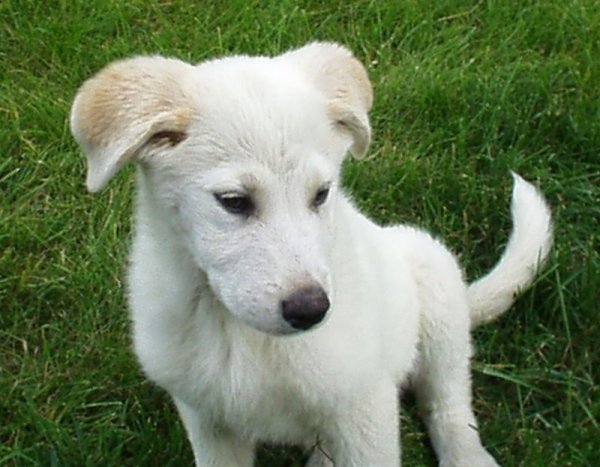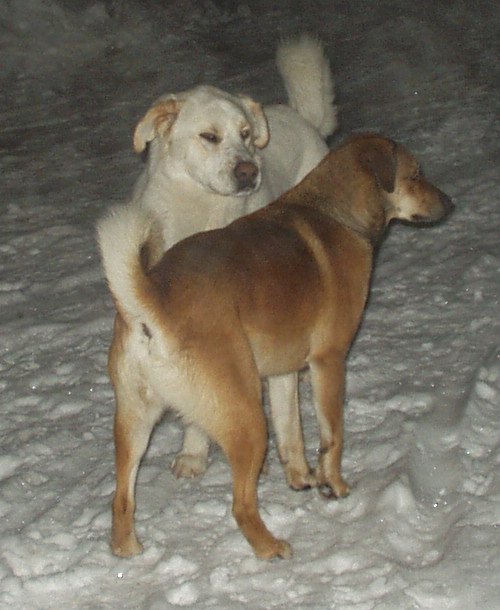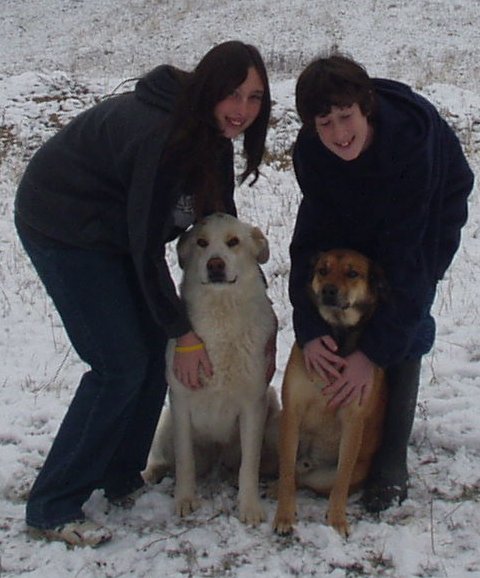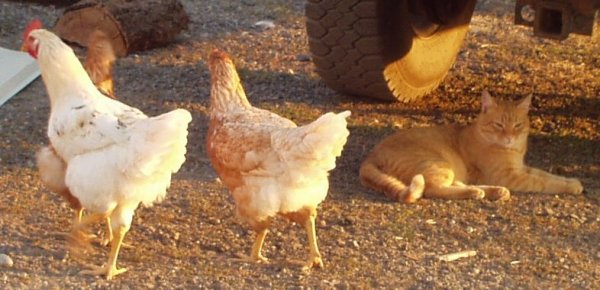Source http://www.richsoil.com/raising-chickens.jsp
paul wheaton permaculture
predator control
When I moved onto my first farm, I was told that nobody in the neighborhood was able to be raising chickens because there was such a serious coyote problem. Sure enough, you can hear them howling and yipping every night. But I was dead set on raising chickens. I told the neighbors that I'll just build some super fence to keep the coyotes out - they told me stories of people with all sorts of amazing fences and the coyotes still killed all of the chickens.Research! I could find lots of people that had some wimpy fence and never had any predator trouble: "Do it like me! You won't have any problems! I promise!" I was tempted, but my gut said that these folks did not have the coyote challenge I faced and if I tried to do what they did, all of my chickens would be killed.
And then I met a woman advocating dogs to protect the chickens. Which struck me as not quite right because not only were coyotes rather dog-like, I've heard of people losing chickens to dogs. This woman had the patience to carefully explain to me that there are certain breeds of dogs that have been bred for thousands of years to protect livestock, including chickens. These dogs would take on a mountain lion to save a chicken. And then the woman told me about how she had built what she was sure was a coyote proof fence only to lose every last chicken to coyotes. And then she got a great pyrenees dog and never lost a chicken to predators after that.
After hearing from two more people with similar experiences with livestock guardian dogs, I bought a great pyrenees pup. Liza. Well, she wasn't a pure bred gret pyr. She had a little anatolian shepherd (another livestock guardian dog breed) and a pinch of saint bernard.

On patrol with henry - a mutt. Henry always followed liza's lead so they made an excellent team.

Liza and henry were both very people friendly.

You could hear liza battle the coyotes nearly every night. First you hear the howling and then about 3/4 of a second later you hear liza running at full speed. About twelve seconds later you hear the howling replaced by "hyipe! yipe! yipe!" - she's run them off.
She patrolled all night for all predators. And if the chickens make a certain noise during the day, she's right there looking to see if there might be any threat.
I have a lot more to say about livestock guardian dogs. But for now, let me just leave it at: if you have acreage, a livestock guardian breed of dog is the way to go. Everything becomes much easier and cheaper.
predator control without a livestock guardian dog (LGD)
If you are not going to use an LGD, then this topic can fill a book. I'm going to only skim the surface of a few of the basics. I'll be happy to explore more details in the forum as people have questions. Maybe some day I'll expand on this topic a bit - but I kinda doubt it since I travel the LGD path.Before leaving biological control behind, I want to mention the use of llamas, donkeys and attack geese: I've heard lots of stories of success and and equal number of stories of failure. The failure stories make sense to me. The success stories make me wonder if the predator pressure may have been low. I think it is possible that there are ways to have llamas, donkeys or geese work to protect your chickens and I just don't fully understand it yet. Or maybe these folks have come across animals that just so happen to have a powerful passion to protect chickens - which leaves one to wonder how to duplicate the process. I have heard that for llamas to be effective, you need to have only one llama - otherwise, the llamas will protect only the llamas and nothing else. If there is only one llama, the llama thinks the chickens are its family and will protect the chickens. There is an excellent book (Livestock Guardians: Using Dogs, Donkeys, and Llamas to Protect Your Herd) that goes into a lot of detail about the finer points of getting llamas and donkeys to work for you. It also covers LGDs quite thoroughly, including all the bits and bobs about breeds. There has also been a fair amount of discussion here.
Let's start simple. Raccoons. Raccoons climb and dig and I have heard that they can break "chicken wire". So they can climb over a fence - or they will even climb a tree to get in and climb a different tree to get out. So a physical barrier alone will be quite the challenge. I suspect that raccoons are the number one reason why folks stop raising chickens.
The most common approach is to close up the coop at night and open the coop again in the morning. Raccoons are mostly nocturnal - and you focus your security effort on the coop. But now you have also added two chores a day that require you to be home on time. And sleeping in in the morning isn't particularly good for the chickens. And forgetting to lock them in at night ... well ... that depends on how often the raccoons test the lock.
I've heard of folks setting up the coop door with a weight or a spring so that if you just pull a small pin, the door will open. And then setting up a wind-up alarm clock that will pull the pin in the morning. All of this so folks can sleep in a bit in the morning. Not a bad idea!
Live traps don't work so good: first, you end up catching animals you don't want to catch. Second, if you catch the raccoon and take it far, far away, you'll find that that raccoon was keeping other raccoons away. So new raccoons come along a little later and you're back to square one.
An electric fence can work very well. You have to make sure that your zapper has a powerful punch. After all, an electric fence is a psychological barrier. When the raccoon encounters it and you don't have a lot of pop, then the raccoon tries to decide if the pain will be worth it - or if it can find a way in without getting shocked. With a big pop, a raccoon thinks DAMMIT! .... RUN AWAY! RUN AWAY!
Using electric fence on large portable paddocks works really well. You should never use electric fence for a small paddock. It's too stressful for the animals inside the paddock.
Anything that works on a raccoon will also generally work on coyotes, dogs, foxes (canines), cats (all sizes), skunks and opossums. Although the canines are more apt to dig than raccoons.
This cat (walter cronkite) generally eats a bird a day - but has never taken a chicken

Weasels (which includes minks) will dig a little and climb a little, but what they are really great at is squeezing themselves through a tiny space and then eating the heads off of all of the chickens. One day all will be great, and the next morning you find all of your chickens have no heads. Weasels can also chew through wood a bit.
Rats are a different sort of problem. They will take eggs and chicks, but I have yet to hear of a rat taking down a grown chicken. More on rats and mice here and here. Snakes can pose a similar problem - going after eggs and chicks.
Raptors (hawks, eagles, owls, etc.) will take chickens and chicks. Some ravens will take chicks. Lots of shrubs and trees seems to solve nearly all of this during the day. A good coop solves the owl problem at night.
A couple of odd contraptions I have heard about but have never tried, nor have I even heard of anybody trying them.
- Motion detecting water squirt. Apparently, when something crosses its sensor, it will aim water at it and squirt it. I guess this won't work during the winter.
- Red-eye thing: I guess you put a bunch of these solar powered contraptions around your property. At night, they have some sort of intermittant red light. This will, supposedly, freak out the predators. They gurantee that it will work. If anybody has any experience with this sort of contraption, please tell us about it in the critter care forum.
paul wheaton permaculture (g+)
No comments:
Post a Comment